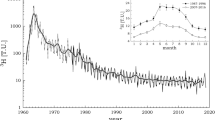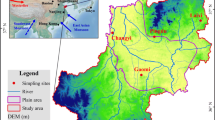Abstract
The Nuclear and Technological Institute (Instituto Tecnológico e Nuclear—ITN) in cooperation with the International Atomic Energy Agency (IAEA) has been conducting a nationwide survey of hydrogen (2H/1H) and oxygen (18O/16O) isotopic composition of monthly precipitation since 1988. This paper focuses on basic features of spatial and temporal distribution of δ18O and δ2H in the precipitation over Continental Portugal derived from ITN database. Phenomenological relationships between stable isotopes composition of precipitation and various climate-related parameters (local air temperature, distance to the Atlantic coast, altitude, amount of precipitation) are established and discussed.
Similar content being viewed by others
Explore related subjects
Discover the latest articles, news and stories from top researchers in related subjects.Avoid common mistakes on your manuscript.
Introduction
The stable isotopes of oxygen and hydrogen incorporated in the water molecule (18O and 2H) have become an important tool not only in Isotope Hydrology—routinely applied to study the origin and dynamics of surface and groundwater—but also in studies related to atmospheric circulation and palaeoclimatic investigations. Spatial and temporal variations of stable isotopic ratios in atmospheric vapour and precipitation are ruled by equilibrium and kinetic isotopic fractionation mechanisms associated with condensation and evaporation processes during global water circulation [1–4].
The content of stable isotopes 2H and 18O in water samples is usually reported as a deviation from the Vienna-Standard Mean Ocean Water (V-SMOW). Delta notation (δ2H and δ18O), commonly used to report the measured isotope variation is defined by the following equations:
The stable isotopic composition of precipitation is related with various environmental parameters, which characterize a given sampling point (e.g. altitude above sea level, distance to the coast, air temperature and rain amount). The distribution of δ18O and δ2H in precipitation mimics the topography of the regions, presenting depleted values at high altitudes, lower temperatures and higher distances from the coast. Dansgaard [2] gave a salient phenomenological evaluation of the isotopic data previous gathered by the IAEA/WMO network, describing the observed distribution of heavy isotopes in relation with a number of environmental parameters. These empirical relationships (so called “effects”) can in fact be considered as measures of the average degree of the rain-out of moisture from the air masses on the way from the source to the site of precipitation.
The Portuguese Network for Isotopes in Precipitation (PNIP) was initiated in 1988 by ITN in collaboration with the Portuguese Meteorological Institute (IM) and with the International Atomic Energy Agency (IAEA) through the Global Network for Isotopes in Precipitation (GNIP). The main objective of our investigation was to determine the monthly variability of the isotopic composition in precipitation along the Portugal mainland. The obtained isotopic dataset (2H, 18O and 3H) is available and part has been submitted to the IAEA to incorporate GNIP database.
Experimental
Since 1988, monthly precipitation samples are being collected in several meteorological stations located in Portugal mainland, one in Madeira Island and two in Azores archipelago. All the samples were measured at ITN. The δ2H and δ18O determinations were performed by mass spectrometry (SIRA 10–VG ISOGAS), following the analytical methods of Epstein and Mayeda [1] and Friedman [5] with an accuracy of ±1.0‰ for δ2H and ±0.1‰ for δ18O. Isotopic composition is expressed by using the delta (δ) notation in ‰ and reported to V-SMOW.
The statistical treatment of all data was guided by three different approaches in order to characterize the seasonal, geographical and climatic features of the precipitation water samples: (i) correlation between the oxygen-18 and deuterium content in monthly precipitation and the geographic location of the stations (latitude and longitude effect); (ii) correlation between the oxygen-18 and deuterium content in monthly precipitation and the regional surface air temperature (seasonal temperature effect); (iii) correlation of the continuous depletion in deuterium and oxygen-18 in monthly precipitation averages with increasing altitude (altitude effect).
Results and discussion
From the climate point of view, mainland Portugal is under the north circulation regime, and the water vapour moisture mostly represents the Atlantic influence. Autumn and winter are the seasons of highest precipitation amounts. The Portuguese network initiated in 1988 was originally composed by seven meteorological stations located in different regions of mainland Portugal. Meteorological stations are located at different altitudes ranging from 9 m near the coastline, up to 1380 m in the interior at Penhas Douradas, an inland station. These geographic situations lead to different climatic features that may induce diverse isotopic compositions either in stable or in radioactive isotopes (Table 1). Since 1991, the number of stations has been reduced to four.
The isotopic evolution of the δ2H and δ18O values, which vary, respectively from −26.9 and −4.54‰ at Porto coastal station to −50.0 and −7.73‰ at Bragança inland station (Table 1), reveals the gradual depletion of the Atlantic air masses from the coast through inland. The long isotopic composition record (15 years) available for 3 stations within Portugal mainland: Porto, Penhas Douradas and Portalegre (with different geographic situations) makes possible to better investigate the seasonal variations of the isotopic composition of precipitation.
δ2H–δ18O relationship
A close relationship between deuterium content and oxygen-18 isotopic composition of precipitation was first reported by Friedman [5] and after by Craig [6]. In his global survey of δ2H and δ18O content of freshwaters, Craig [6] reports the best fit line as δ2H = 8 δ18O +10, later named Global Meteoric Water Line (GMWL), commonly used to identify and characterize all meteoric waters origin. In 1964 Dansgaard [2] introduce a new concept in Isotope Hydrology the “deuterium excess”, defined as d = δ2H–8δ18O.
Figure 1a represents the long-term annual mean δ18O and δ2H values for all the analyzed precipitation samples collected in the Portuguese Network, δ2H–δ18O plot. The slope of the GMWL is controlled by the ratio of equilibrium isotope enrichments for deuterium and oxygen-18, respectively [2, 7]. A high positive correlation was obtained, although in a regional scale, small deviations have been observed from the isotopic composition of the GMWL. This is the case of the correlation obtained for the precipitation samples over Portugal (δ2H = (6.78 ± 0.10) δ18O + (4.45 ± 4.64); r = 0.95; n = 405). The differences are most probably related with the geographic location, altitude and local surface air temperature, in spite of the small dimensions of Portugal mainland (approximately 700 vs. 150 km).
To investigate the origin of the water masses the deuterium excess values were plotted along the year (monthly weight mean) (Fig. 1b). Similar patterns are observed for all the stations, which suggests a common source of the water vapour. An apparent seasonality of d-excess values is observed due to lower relative humidity (normalized to the sea surface temperature) over the ocean during winter time.
Isotopic distribution patterns
According to Peixoto and Oort [8] the major global source of water vapour is the tropical ocean, and approximately 65% of the global evaporation flux over the oceans originates between latitudes 30ºS and 30ºN. Global scale studies put in evidence the depletion in heavier isotopes in the precipitation samples collected at mid-latitude continental stations when compared to coastal or marine stations located at identical latitude (“latitudinal effect”). There is a tendency to observe more negative δ18O values in precipitation with increasing distance from the coast. This feature is known as “continental effect”. Basically the same mechanism is responsible for both effects, i.e. gradual removal of moisture from air mass during its inland movement, coupled with preferential removal of heavy isotopes during the condensation process.
A high correlation was obtained between the isotopic composition of precipitation samples (monthly precipitation record) and geographic location (Fig. 2a). Data show an isotopic depletion in precipitation samples in stations situated at higher latitudes (Bragança and Vila Real), and between continental and coastal stations when located at comparable latitudes (Vila Real and Porto). More negative δ18O values in precipitation were measured with increasing distance from the coast (Bragança and Porto).
The isotopic gradient—temperature effect—obtained show some deviation from those presented by Rozanski [3], namely 0.69‰ per °C and 5.6‰ per °C for oxygen-18 and deuterium, respectively. These authors point out that the Δδ18O–ΔTemperature relationship is non-linear, the slope change from 0.66‰ per °C to 0.17‰ per °C in 18O, for surface air temperatures lower than −10 °C and higher than 10 °C, respectively. The apparent link between local surface air temperature and the isotope composition of precipitation open new fields of application, mainly due to the applicability of stable isotopes as palaeoclimatic indicators.
In general, the distribution of δ18O and δ2H mimics the topography of the continents (e.g. mountain chains are marked by more negative δ values). In the present study the hydrogen and oxygen isotope content of the rain samples are correlated with the altitude of meteorological stations (Fig. 2c): δ18O (‰) = −0.002 Altitude (m)—5.025; (r = 0.78) and δ2H (‰) = -0.014 Altitude (m)—29.667; (r = 0.70). Consequently, the altitude effect for Portugal mainland is about 0.2‰ per 100 m for 18O and 1.4‰ per 100 m for 2H. The lowering of temperature with increasing elevation in mountain regions usually leads to enhanced condensation and therefore to a progressive depletion in heavy isotopes in precipitation. This “altitude effect” has been used in numerous hydrological studies to identify the recharge areas of the groundwater systems and to investigate the origin and interconnection of different water bodies. The isotopic gradients estimated are in agreement with the vertical isotope gradients found in literature, which vary between −0.15 and −0.50‰ 100 m−1 for 18O and from about −1 to −4‰ 100 m−1 for 2H [4].
Conclusions
An apparent link between the isotopic composition of precipitation and the local geographic and climatic features was identified over mainland Portugal, characterized by:
-
(i)
a mean value of 0.21 ‰ per °C in 18O for the isotopic fractionation with the regional temperature. The relation between local surface air temperature and the isotope composition of precipitation is rather important due to the applicability of stable isotopes as palaeoclimatic indicators (palaeohydrology and palaeoclimatology);
-
(ii)
a mean isotopic gradient of 0.2 ‰ per 100 m for 18O and 1.4‰ per 100 m for 2H, with the altitude. The “altitude effect” is being used to identify the recharge areas and investigate the origin and interconnection of different water bodies, essential in water resources management;
-
(iii)
δ18O values in precipitation increase with the distance from the coast, pointing to a common origin of the air masses—the Atlantic Ocean.
References
Epstein, S., Mayeda, T.: Variation of 18O content of water from natural sources. Geochim. Cosmochim. Acta 4, 213–224 (1953)
Dansgaard, W.: Stable isotopes in precipitation. Tellus 16, 436–468 (1964)
Rozanski, K., Araguás-Araguás, L., Gonfiantini, R.: Isotopic patterns in modern global precipitation. Climate change in continental isotopic records. American Geophysical Union. Geophys. Monogr. 78, 1–36 (1993)
Araguás-Araguás, L., Froechlich, K., Rozanski, K.: Deuterium and oxygen-18 isotope composition of precipitation and atmospheric moisture. Hydrol. Process 14, 1341–1355 (2000)
Friedman, I.: Deuterium content of natural waters and other substances. Geochim. Cosmochim. Acta 4, 89–103 (1953)
Craig, H.: Isotopic variations in meteoric waters. Science 3465, 1702–1703 (1961)
Merlivat, M., Jouzel, J.: Global climate interpretation of the deuterium-oxygen 18 relationship for precipitation. J. Geophys. Res. 84, 5029–5033 (1979)
Peixoto, J.P., Oort, A.H.: Variations in the Global Water Budget, p. 5. D. Reidel Publishing Company, Dordrecht (1983)
Author information
Authors and Affiliations
Corresponding author
Rights and permissions
About this article
Cite this article
Carreira, P.M., Nunes, D., Valério, P. et al. A 15-year record of seasonal variation in the isotopic composition of precipitation water over continental Portugal. J Radioanal Nucl Chem 281, 153–156 (2009). https://doi.org/10.1007/s10967-009-0064-0
Received:
Published:
Issue Date:
DOI: https://doi.org/10.1007/s10967-009-0064-0






